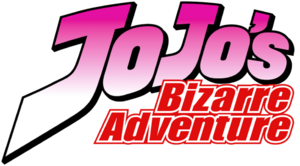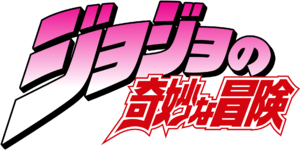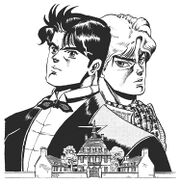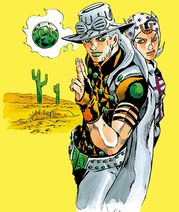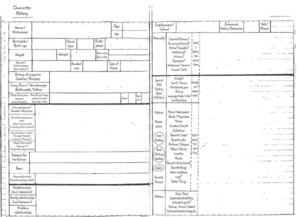User:Pot Hants/Sandbox2

|
Note: This is a user's personal page attached to their profile! This is not an actual article, may not be related to JoJo or Araki, and is not associated with the wiki. As such, it may not adhere to the policies. |
معرفی
جوجو از سال ۱۹۸۷[1] تا ۲۰۰۴ در مجلهی هفتگی شونن جامپ به چاپ رسیده است و بعد از آن به مجلهی ماهانهی سینن اولترا جامپ منتقل شد و تا به امروز داستان آن ادامه داشته است. این مجموعه در نسخههای مختلفی به چاپ رسیده که شامل نسخهی استاندارد تانکوبون و نسخههای ویژه مانند بانکوبان و کانزبان است که همهی نسخهها دربردارندهی چپترهای چاپ شده در مجلات شونن جامپ هفتگی و اولترا جامپ هستند. در بعضی نسخهها از نامهای جدیدی برای چپترها استفاده شده است و در برخی دیالوگها تغییراتی انجام شده است.
از این مجموعه تا کنون صد میلیون نسخه به فروش رفته است[2] که آن را به یکی از پرفروشترین مانگاهای تاریخ بدل میکند. با به چاپ رسیدن ۱۳۱ جلد از این مجموعه، جوجو به دومین مانگای طولانیمدت انتشارات شوئشا تبدیل شده است. انتشار نسخهی انگلیسی این مجموعه همچنان در جریان است.
جوجو دارای ژانرهای گستردهای از جمله اکشن، ماجراجویی، ماورای طبیعت، مهیج، کمدی، تراژدی، معمایی، برشی از زندگی و وحشت است. از این مجموعه موارد مختلفی میان خوانندگان به شهرت و محبوبیت رسیده است. میتوان در این رابطه به پدیدهی استند؛ سومین پارت مجموعه استارداست کروسیدرز و شخصیتهای آن دیو براندو (DIO) و جوتارو کوجو؛ بیانات رسای شخصیتهای پرغرور و جذاب و صدها ارجاع به نامهای موسیقیهای محبوب غربی اشاره کرد.
آراکی اسپینآفها و آرتبوکهای متعددی برای مجموعهی جوجو تألیف کرده است که دنیای جوجو را گسترش دادهاند. همچنین لایت ناولهای مختلفی از جوجو توسط نویسندگان مختلف تألیف شدهاند که تصویرگری همهی آنها بر عهدهی آراکی بوده است.
جوجو در گذشته طولانیترین مانگای شوئشا بود که هنوز از آن اقتباس انیمهای برای تلوزیون ساخته نشده بود. اما بالاخره در ۶ اکتبر ۲۰۱۲ به صورت رسمی خبر ساخت انیمهی تلوزیونی (رسیدن فاصلهی آغاز مانگا و آغاز انیمه به ۲۵ سال) توسط استودیوی انیمیشن دیوید پروداکشن اعلام شد.
محصولات جانبی مختلفی نیز برای سری جوجو عرضه شدهاند که شامل سه بازی ویدیویی مبارزهای هستند که به صورت بینالمللی عرضه شدهاند؛ Heritage for the Future از شرکت کپکام (روی سیستم CPS-3) در سال ۱۹۹۸؛ بازی All Star Battle از شرکت باندای نامکو روی کنسول PS3 در سال ۲۰۱۴ و Eyes of Heaven روی کنسول PS4 در سال ۲۰۱۶.
راهنما
خلاصه
داستان مجموعهی جوجو به دو بخش تقسیم میشود. بخش اول شامل پارتهای ۱ تا ۶ است که از ۱۹۸۷ تا ۲۰۰۳ در مجلهی شونن جامپ هفتگی به چاپ رسید. بخش دوم که شامل پارتهای ۷ و ۸ است از سال ۲۰۰۴ تا امروز در مجلهی سینن اولترا جامپ در حال انتشار است. در طول این پارتها، داستان به قسمتهای مختلفی تقسیم شده است که هر کدام روی یکی از نبردهای بزرگ و پرمخاطره و پراحساس میان طرفین دارای قدرتهای ماورای طبیعت استند با جاهطلبیها، نگرشها و ارزشهای اخلاقی مختلف تمرکز میکند. هر پارت فضایی مخصوص به خودش را از نظر لحن، داستان، تعلیق، معما و وحشت دارد و داستان در همهی پارتها با فضای اکشن و با چاشنی کمدی جلو میرود. معمولا داستان حول حور قهرمانهایی میچرخد که در تلاشند در برابر یک شخصیت شرور اصلی بایستند و جلوی او را بگیرند.
در سری جوجو ارجاعات متعددی به فیلمها، برنامههای تلوزیونی، فشن، هنرهای زیبا و موسیقیهای محبوب در فضا و شخصیتهای داستان از جمله نام آنها قابل یافتن است. در راستای خلق استندهای مختلف نیز از نظریههای فیزیکی، ریاضی و روانشناختی، زیستشناسی، فناوری، افسانهها، پدیدههای طبیعی، حوادث تاریخی و برخی آثار هنری برای طراحی ظاهری و قدرت و عملکرد آنها الهام گرفته شده است. برای مثال در نظریههای علمی معاصر با خلق داستان، تحولاتی خیالپردازانه انجام میشود و از آنها برای برای خلق برخی استندها و دیگر قدرتها و نحوهی تعامل آنها با طبیعت استفاده میشود.
موریو، شهر داستان الماس شکستناپذیر و شهر متناظرش در جوجولیون، شهری خیالی در کشور ژاپن است که برگرفته از زادگاه آراکی یعنی شهر سندای[3] است که از نظر فرهنگی و برخی موضوعات (مانند زلزلهی توهوکو در سال ۲۰۱۱) شباهتهایی میان آن دو وجود دارد. همچنین یکی از ساکنین شهر موریو در الماس شکستناپذیر مانگاکا و کاربر استند روهان کیشیبه است که در اسپینآفهای متعددی از جوجو نیز حضور دارد.
در سال ۲۰۰۶ وقتی از نویسندهی مجموعه هیروهیکو آراکی خواسته شد تا درونمایهی جوجو را در یک عبارت توصیف کند، او «معمای ذات انسان» و «ستایش انسان» را در پاسخ گفت[4] و مدیوم مانگا را «رستگاری جان» توصیف کرد.[5] از موضوعاتی که در جوجو به آنها پرداخته شده است میتوان به سرنوشت، شهامت و عدالت اشاره کرد.
داستان دنیای اولیه
دنیای اول داستان دشمنی میان نسلهای مختلف خاندان جوستار و نیروهای شرور را به تصویر میکشد که سرآمد آنها دیو براندو و پیروانش است.
خون شبح
داستان پارت اول خون شبح در سال ۱۸۸۰ در انگلستان جریان دارد و جاناتان جوستار را که در طول داستان رشد میکند و در انتها جلوی برادر ناتنیاش میایستد به تصویر میکشد. برادر او دیو براندو مردی زیرک و بیرحم است که به کمک نقاب سنگی تبدیل به خونآشام میشود. جاناتان توسط ویل آنتونیو زپلی برای استفاده از ریپل آموزش میبیند. ریپل امواج انرژی است که در بدن تولید میشود و در نبرد از طریق مشت به حریف منتقل میشود و تنها راه در کنار نور خورشید است که میتوان خونآشامها و زامبیها را شکست داد.
گرایش به نبرد
دومین پارت گرایش به نبرد جوزف جوستار نوهی جاناتان را به تصویر میکشد که در دوران منتهی به جنگ جهانی دوم در سال ۱۹۳۸ برای مبارزه با مردان ستونی دور دنیا سفری میکند؛ نژادی خصومتآمیز که در دوران کهن نقاب سنگی را به وجود آوردند. جوزف مانند پدربزرگش تحت تمرینات شدید به همراه سزار آنتونیو زپلی نوهی ویل ریپل را توسط استاد مرموز لیسا لیسا فرامیگیرد. آنها در تلاشند تا از سنگ قرمز آجا در برابر مردان ستونی که به دنبال تکمیل نقاب سنگی و ایمنی در برابر نور خورشید هستند محافظت کنند.
Stardust Crusaders
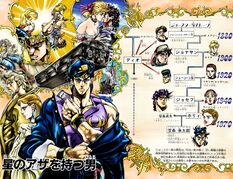
The three first parts constitute a trilogy after which Hirohiko Araki intended to end the series, but JoJo's Bizarre Adventure continued nonetheless after the end of the third part.[6]
Diamond is Unbreakable
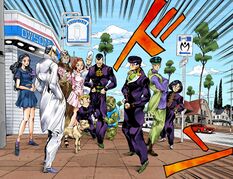
The fourth part Diamond is Unbreakable is set in the fictional town of Morioh, Japan, in 1999. It follows Joseph's illegitimate son Josuke Higashikata as he meets friends and enemies among a host of new Stand users within the population of Morioh created with the Bow and Arrow, two items which gave DIO his Stand. He, Okuyasu Nijimura, Koichi Hirose, Jotaro Kujo, and Rohan Kishibe eventually chase the serial killer Yoshikage Kira.
Vento Aureo
In the fifth part Vento Aureo, set in Italy 2001, DIO's son Giorno Giovanna fights his way to the top of Passione, the most powerful gang in Italy, as he plots to overthrow the gang's mysterious Boss in order to protect the civilian populace from the gang's drug trade. To do so he cooperates with gang member Bruno Bucciarati and his own team of Leone Abbacchio, Guido Mista, Narancia Ghirga, and Pannacotta Fugo as they are tasked with protecting the Boss' daughter Trish Una from the assassin teams La Squadra Esecuzioni and Unità Speciale.
Stone Ocean
The sixth part, Stone Ocean, is set in 2011 as Jotaro's estranged daughter Jolyne Cujoh is framed for murder and imprisoned in Green Dolphin Street Prison. Jotaro then has both his memories and Stand stolen by the Stand Whitesnake after an attempt to free Jolyne. She then decides to stay imprisoned in order to find out both who Whitesnake's user is and what he plans to do with Jotaro's memories and Stand. Along her adventure, Jolyne gains allies in Emporio Alnino, Ermes Costello, Foo Fighters, Narciso Anasui, and Weather Report.
Alternate Universe Continuity
Steel Ball Run
Set in 1890 in the United States, Steel Ball Run follows a race across the continent of the United States of America. The race is called the Steel Ball Run horse-race and is named after the sponsor, Steven Steel. The protagonists are Gyro Zeppeli, a master of the unique Spin technique seeking the cash prize and Johnny Joestar a paraplegic ex-jockey seeking to cure his legs through the Spin, both cooperating to win the race. Johnny and Gyro discover that the race is a cover-up from the President Funny Valentine to uncover the powerful and invaluable relics of Jesus Christ, eventually also hunting for said relics while fending off Valentine's many agents.
JoJolion
Leaping to 2011 in JoJolion, university student Yasuho Hirose discovers an amnesiac man tentatively named "Josuke" in Morioh after the (then-contemporary) Great East Japan earthquake. Both then decide to investigate Josuke's past identity, initially thought to be that of the ship's doctor Yoshikage Kira, and the circumstances of his presence in town, leaving him in the care of the affluent Higashikata Family as both uncover the family's darkest secrets and a drug trade involving a mysterious race of humanoid beings and an equally mysterious fruit.
JOJOLANDS
The 9th part of JoJo's Bizarre Adventure, JOJOLANDS is set in an as-of-yet unknown time period and location. The name was revealed in the author's note of the September 2021 issue of Ultra Jump on August 19th, 2021.
The second continuity features many nods to characters of the former continuity including restyled main characters, Stands and locations.
Parts
| No. | Title | Original Run | Volumes |
|---|---|---|---|
| 1 | 1987 – 1988 | 5 | |
| Beginning in 1880, Part 1 follows Jonathan Joestar as he matures with and eventually combats his adoptive brother, the cunning, merciless Dio Brando. | |||
| No. | Title | Original Run | Volumes |
|---|---|---|---|
| 2 | 1988 – 1989 | 7 | |
|
Set in 1938, Part 2 follows Joseph Joestar, grandson of Jonathan, who finds himself embroiled in a war against ancient super-beings named the Pillar Men, creators of the Stone Mask. | |||
| No. | Title | Original Run | Volumes |
|---|---|---|---|
| 3 | 1989 – 1992 | 16 | |
| Part 3, set in 1989, follows Jotaro Kujo, who has acquired the power of Stand, and his allies as they journey from Tokyo to Cairo to save his mother's life by defeating his family's archenemy, DIO. | |||
| No. | Title | Original Run | Volumes |
|---|---|---|---|
| 4 | 1992 – 1995 | 18 | |
|
In Part 4, set in 1999 in the fictional town of Morioh, high-schooler Josuke Higashikata and his friends seek out the Arrow, which has the power to give Stand abilities, as well as the serial-killer Yoshikage Kira. | |||
| No. | Title | Original Run | Volumes |
|---|---|---|---|
| 5 | 1995 – 1999 | 17 | |
| Part 5, set in Italy in 2001, follows the adventure of Giorno Giovanna, the son of DIO, in his ambition to rise within the Italian mafia by subverting the dominant gang Passione and its mysterious Boss with the aid of a team of fellow Stand users. | |||
| No. | Title | Original Run | Volumes |
|---|---|---|---|
| 6 | 2000 – 2003 | 17 | |
|
In Part 6, 2011, Florida, Jolyne Cujoh, daughter of Jotaro Kujo, is framed for murder and thrown in the Green Dolphin Street Prison. She and her allies struggle to discover who is responsible for what and what are they planning to do. | |||
| No. | Title | Original Run | Volumes |
|---|---|---|---|
| 7 | 2004 – 2011 | 24 | |
|
Beginning another continuity, Part 7 follows Gyro Zeppeli, master in a mystic art named the Spin, and Johnny Joestar, a paraplegic ex-jockey, as they compete with a vast number of others in the highly rewarded Steel Ball Run race in the U.S. in 1890, designed in part by the American government. | |||
| No. | Title | Original Run | Volumes |
|---|---|---|---|
| 8 | 2011 - 2021 | 27 | |
|
Part 8 begins in 2011 and follows Josuke Higashikata, a young man afflicted by retrograde amnesia, on his search to uncover his identity in Morioh, a coastal Japanese town affected by the Tohoku earthquake. | |||
| No. | Title | Original Run | Volumes |
|---|---|---|---|
| 9 | ? - | ? | |
|
TBD | |||
Publication
Chapters are serialized in Weekly Shonen Jump and Ultra Jump, under Shueisha. While in Weekly Shonen Jump, the series was published under the tagline "Romantic Horror! -A Crimson Tale-" (ロマンホラー!—深紅の秘伝説—, Romanhorā!-Shinku no hi densetsu-). The tagline was created by the editorial department at Shueisha and was included in every chapter up until Stone Ocean.
In North America and the United Kingdom, Stardust Crusaders was translated into English and published in 16 volumes by VIZ Media from November, eighth 2005 to December 7, 2010 under the title of JoJo's Bizarre Adventure, skipping both Phantom Blood and Battle Tendency. On June 9, Viz Media published the first three parts of JoJo's Bizarre Adventure from the JoJonium line of manga, from February 24, 2015 to February 5, 2019, marking the first English publications of Phantom Blood and Battle Tendency. On July 6, 2018, Viz Media announced they would be releasing an English publication of Diamond is Unbreakable. The first volume of Diamond is Unbreakable was released on May 7, 2019, and finished on May 4, 2021. On August 3rd 2021, Viz Media released the first volume of Vento Aureo in English.
In Italy, Star Comics began publishing the series in a monthly format under the title Le bizzarre avventure di JoJo from November 1993 to April 2004,[7] these monthly releases contained around five chapters in each trade paperback with 126 paperback volumes released. These releases would then be followed up in March 2006 with translations of the Steel Ball Run volumes that were published until February 2012. During this time, Star Comics published the JoJo's Bizarre Adventure (Bunko Edition) volumes with their Italian translation of the series starting from 2010. Currently, they have been publishing JoJolion since February 2014 and have begun releasing the JoJonium volumes since October 2019 with further releases still on-going.
In France, the first four parts were published by J'ai lu[8] from January 2002 to December 2005. In 2007 publisher Tonkam (now a subsidiary of editions Delcourt resumed the publication of the following parts starting with a publication of Vento Aureo, the previous parts would later see revised releases under Tonkam's publication starting with Stardust Crusaders and then going back to Phantom Blood and continuing from there. Currently, they are publishing JoJolion.[9]
In Spain, the entire series is being published by IVREA. Phantom Blood started publication on June 30, 2017. This publication uses the same volume count as the Bunko Edition volumes, these volumes come out monthly. They are currently publishing Stone Ocean as part of their publication.
In Argentina, the first four parts are being published by IVREA Argentina.
In Mexico, the first five parts are being published by Panini. Publication started on August 1, 2018 with Phantom Blood using the same volume count as the Bunko Edition volumes, these volumes come out monthly. The current part in publication is Vento Aureo.
In Brazil, the first three parts are being published by Panini. Phantom Blood started publication on July 19, 2018. This publication uses the same volume count as the Bunko Edition volumes, these volumes come out monthly. The current part in publication is Diamond is Unbreakable.
In China, JoJo was illegally distributed under the title Strongman Front (強人陣線) by Tong Li Comics for many years until Daran Comics obtained the official publishing license for JoJo, renaming the comic JoJo Adventure Wild (JoJo冒險野郎). On March 31, 2003 Daran Comics shut down their offices and their license for JoJo was officially obtained by Tong Li Comics who now officially distributes the series in Taiwan and reverted the title of the series back to JoJo's Bizarre Adventure (JoJo的奇妙冒險). Currently, the series is being published by World Publishing Limited as they are currently releasing a publication of JoJolion.[10]
In Poland, the series is being published by J.P.Fantastica. Publication started in May 2020 with Phantom Blood using the same volume count as the JoJo's Bizarre Adventure: Shueisha Comic Bunko. The current part in publication is Stardust Crusaders.
Making-of
When he first conceived JoJo's Bizarre Adventure, Araki was throwing around several core ideas he wanted to portray such as an idea of succession between generations, but also to show travelling heroes. From there he began to set up his ideas for Phantom Blood. Araki notes that the process of creating JoJo went from fight to a more spiritual aspect, and that concepts like friendships took a greater place over time.[11] Araki had several themes in mind too, such as the idea of "mystery",[12] and notably the mystery coming from bloodlines. He also asked himself "Who is the strongest person in the world?" and derived from this question themes such as immortality, seeking life, or justice.[12] More importantly, Araki felt that he could create something unique among the current series at Weekly Shonen Jump with these ideas. Araki had initially only planned for three parts,[13] but decided to continue with his series.
Writing JoJo
Araki gives precedence to emotion and inner thought over plot structure, trying to portray the protagonists' destiny.[12]
Araki follows a particular narrative style called the "golden road", characterized by strong and determined protagonists who constantly advance towards their objectives. This "golden road" is, according to him, the best way to draw in the audience. One example of his "golden road" is the plot of Stardust Crusaders during which the heroes always manage to defeat the enemies on their paths and inexorably approach Egypt. Araki is not avert to killing off his protagonists like Jonathan Joestar but feels that if the death served a greater purpose then he still abides by the "golden road".[14] Araki thinks the basic plot of his parts around a particular predicament and likes to throw his protagonist quickly into said predicament before continuing off his story from there (e.g. Johnny Joestar is paraplegic and wants to find a way to heal his legs).[14] Araki also use a rather original plot structure for the series. Instead of the classical "tournament" format of most other series at the time where the heroes fought enemies in a predictable increasing order of strength, Araki adopted a sugoroku style (sugoroku is a table-top game similar to snakes and ladders) where the heroes would travel and then meet enemies at particular points in said journey and the fights would be more varied due to a better variety of powers, and an emphasis on wit rather than force.[15] Araki also denounces the long-term limitations of always increasing the strength of enemies in a serialized manga.[12][16]
Araki takes inspiration from a variety of sources to write his series. He has confirmed several times that he uses Western music to name his characters, but also copies designs from varied sources such as artbooks, comic books, the news, or movies. Araki extensively uses books rather than online research.[17] One lesser known aspect of his research is that he often travels to the places he depicts in the series in order to have a better feeling of the place and gather details that an online research wouldn't give. His first tanto Ryosuke Kabashima encouraged him to see movies for inspiration and also travel.[18] Kabashima notably coerced Araki into travelling to Egypt to later depict it in Stardust Crusaders.[19] Araki would later on keep this habit and went to Italy for Vento Aureo[20] and went to a correctional facility in Florida too to get inspiration for Green Dolphin Street Prison,[21][22] as well as Orlando.[23] He also went on several long journeys in the USA and Japan to better write Steel Ball Run too.[24] His habit of travelling to research places extended to individual buildings such as a hospital or a drug store.[25]
Araki makes it a point to never rest on his laurels and always find new ideas. For instance, Araki was displeased to think he had reached a summit with Stone Ocean in terms of idea and had decided to erase the original continuity and revisit his old ideas in a second continuity.[26] His will to always change is also notable on his art (though he explains it as avoiding drawing old art rather than deliberately change).[27] Araki's art style has changed considerably over the years, although he had always kept core ideas about his art such as his dramatic poses and representation of an ideal human body. For instance, muscle-bound heroes were popular in the 80s so Araki drew these types of characters (e.g. Jonathan), but as trend changes, Araki transitioned to more normal-looking characters like Giorno, a slimmer pretty boy character type.[11][28] The unusual sound effects Araki inserts in his page are inspired from horror movies and rock music, akin to scare chords and other noises produced by synthetizers and mellotrons.[28]
During its publication in the Weekly Shonen Jump magazine, Araki continuously tried to push for unique ideas, often infringing on what was considered acceptable for the magazine. Araki notably decided to make his first protagonist a foreigner and then kill him off to replace him, which was a taboo. Araki also had tried to write female protagonists for the series, with notably Giorno Giovanna being initially thought as a young woman. This would be eventually portrayed with Jolyne Cujoh, whose sex he insisted on despite his editor's requests. Araki notably thought that it was then acceptable to portray women being subjected to violence as intense as male characters were being exposed to.[28][29] It led to several conflict with the editorial team who tried to tone down the violence and themes Araki wanted to write about.[30]
When Araki creates a character, he thoroughly completes a datasheet about said character, which includes their physical characteristics, their tastes, and background information like a potential family.[31] Araki notes that his habit of naming characters after bands and albums is a simple hobby, and a way to pay his respect to the musicians he likes.[12]During his time at the Weekly Shonen Jump, Araki had the following schedule: Sundays were spent finding ideas, Mondays were spent making the draft storyboard for the chapter. He then met with his editor and began drawing more elaborate sketches, one page at a time. Tuesday, Wednesday and Thursday were spent finishing drawing the chapter for the publication of the Weekly Shonen Jump magazine, and Friday and Satudary were spent resting.[32] This schedule that Araki followed strictly was set up by Kabashima too.[18] This notably allowed Araki to keep in shape, and he was also noted as being always on time for his chapters.[33] His currently monthly schedule seems to have stayed the same as his weekly schedule, with Fridays and Saturdays off. Araki adds that he wakes up at 10 AM, begins working at 11 AM, takes a break at noon, and finishes his work day at Midnight.[34] Araki says that his current 45 pages a month match his natural pace better.[17] Thanks to his strict schedule, Araki has never missed a deadline in his career.[17][33]
Trivia
- List of cultural references in JoJo's Bizarre Adventure
- List of cultural references and inspirations from JoJo's Bizarre Adventure
- The 25th year of JoJo's continuous publication is commemorated in part by a booklet titled 25 Years With JoJo, featuring fan art by mangakas including Eiichiro Oda, Akira Toriyama, and Osamu Akimoto.
- As of the end of JoJolion, the series has a page count of 24,047 among its eight parts (24,673 including one-shots).
References
- ↑ یادداشت: اولین چپتر در مجله در تاریخ ۲ دسامبر ۱۹۸۶ منتشر شد - Weekly Shonen Jump #940 - No. 1-2, 1987
- ↑ http://www.araki-jojo.com/1151/
- ↑ Morioh Map (JoJolion)
- ↑ [Question for Araki-sensei! (13): "If you can describe JoJo in a single word"] - comipress.com, 2007
- ↑ [Question for Araki-sensei! (9): "If You Can Describe Manga in A Single Word"] - comipress.com, 2007
- ↑ JoJonium Special Interviews: Volume 8, Jotaro Kujo
- ↑ Le bizzarre avventure di JoJo First Italian release November 1993
- ↑ J'ai lu
- ↑ https://www.editions-delcourt.fr/auteur/araki-hirohiko.html
- ↑ JoJo的奇妙冒险 Chinese Wikipedia page for the JoJo series
- ↑ 11.0 11.1 Animeland Interview 06/2003
- ↑ 12.0 12.1 12.2 12.3 12.4 Tokai Lecture 06/2006
- ↑ Weekly Shonen Bracket 100Q
- ↑ 14.0 14.1 Hirohiko Araki's Manga Technique chapter 4
- ↑ NYT Japan interview 11/2018
- ↑ Volume 45, Volume 46 Author's note
- ↑ 17.0 17.1 17.2 Dream Talk Sessions 2015
- ↑ 18.0 18.1 JOJOVELLER History 1979-2013
- ↑ Manga Heaven 06/2007
- ↑ Author's Note (Vento Aureo) vol.48
- ↑ SO Volume 1 special thanks
- ↑ SO Volume 5 Author's Note
- ↑ SO Volume 12 Author's Note
- ↑ P7 Bunko 1 afterword
- ↑ Volume 41 Author's Note
- ↑ P6 Bunko Vol.11 Afterwords
- ↑ JOJOmenon interview
- ↑ 28.0 28.1 28.2 PS2 Game interview
- ↑ P6 Bunko Vol.1 Afterwords
- ↑ P5 Bunko Vol.1
- ↑ Manga in Theory and Practice chapter
- ↑ JoJo6251 Araki interviews
- ↑ 33.0 33.1 JOJOVELLER 2013 Azuma interview
- ↑ https://jojowiki.com/Interview:Asahi_Shinbun_(September_2013)
